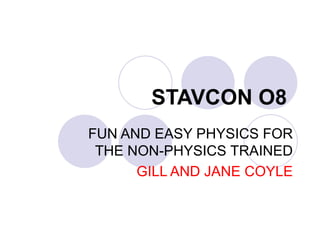Fun and East Physics for the non-physics trained
- 1. STAVCON O8 FUN AND EASY PHYSICS FOR THE NON-PHYSICS TRAINED GILL AND JANE COYLE
- 2. OUR AIMS FOR THIS SESSION… To demonstrate and explain a number of activities that have worked really well in junior physics topics Provide play time for session participants to gauge usefulness of activities to their curriculum’s needs . Handouts/sheets provided Please fill in feedback form to help Jane & Gill for next time.
- 3. As you play fill in your table… Activity Topic Year level Where it fits for my school’s units Notes
- 4. Activity 1 - Toys and Forces Activity 2 – Miming Forces Activity 3 – Air Resistance Relays Activity 4 – Investigating Fluid Friction Year 7 Forces Activities – see your notes First two activities great intro activities Activity 3 gets them out doing PE and science Activity 4 Assessment task.
- 5. Explaining the physics What are forces? Something that can make an object change speed or direction Can we see a force? Not always, but we see the result of a force. When investigating the toys try to identify the driving forces and the retarding force
- 6. But what if I get a ……. question like…. What is magnetism, gravity, electrostatics, friction?
- 7. Magnetism Magnetic fields are created by the movement of electrons. The easiest way to make electrons move is using a battery. Danish scientist Hans Christian Oersted discovered that if you hold a current carrying wire near a compass, the needle moves to be at right angles to the wire. But what about Earth’s magnetism? Simply put the Earth’s molten layer is constantly moving and this movement includes free electrons. Thus we have the same scenario as electrons moving in our wire: Moving electrons = Magnetic field Bar Magnets are probably the trickiest to explain. Due to their particular chemical make up metals such as Iron, Nickel and Cobalt are able to become magnetic and remain magnetic when exposed to an external magnetic field
- 8. Gravity Isaac Newton’s Philosophiæ Naturalis Principia Mathematica published in 1687, is considered to be the most influential book in the history of science. In this Newton described the Universal Law of Gravity. Every object in the Universe attracts every other object in the universe. When we experience gravity standing on the Earth there is a mutual attraction between and Earth and ourselves
- 9. Electrostatics Electrons are everywhere! They hold a negative charge. When an object gains extra electrons its charge becomes negative When an object looses an electron its charge becomes positive Opposite charges attract, like charges repel When we rub material like a balloon (insulator) on our hair, electrons are ripped from our hair and build up on the balloon. This is described as static because the electrons cannot travel through the material. This makes your hair positively charged and the balloon negatively charged, thus they attract.
- 10. Friction Friction occurs due to chemical and electrostatic interactions between two material in contact Friction works against the direction of motion Friction increase the heavier the object or the harder you push down Friction causes heat
- 12. Air resistance Air resistance is a form of friction. The shape of on object will change its air resistance
- 13. YEAR 10 EM SPECTRUM - SOLAR COOKERS
- 14. But what if I get a……. Curly question like….. What is light?
- 15. What is Light? This is a real curly question. The truth is we don’t really know. We use several models to explain what light can do but none of them can describe light completely on their own. Ray model Particle model Wave model
- 16. Ray Model The ray model uses straight lines to show the path of a single ray of light. You would likely have seen ray diagrams and used them in yr 8 or 9 science
- 17. Particle model The particle model describes light as small packets of energy called photons. The particle model is needed to explain light produced in fluorescent tubes as well emission and absorption spectral lines of elements.
- 18. Wave Model Many properties of light can be identifies as wave properties: interference, refraction and diffraction We also need the wave model to explain colour, and to determine the energy of a photon.
- 19. Detecting UV Radiation – Using UV sensitive Beads Testing Effectiveness of Sunglasses, sunscreen and bathers.
- 20. Now lets go and play………



















